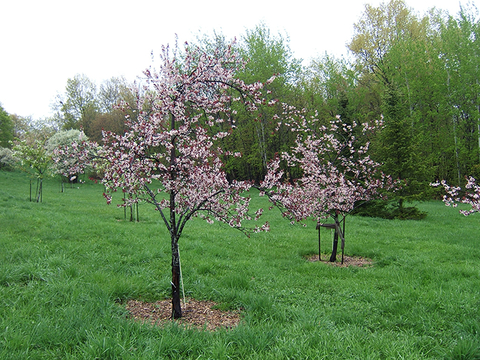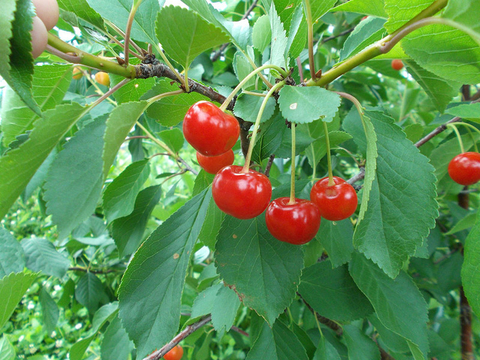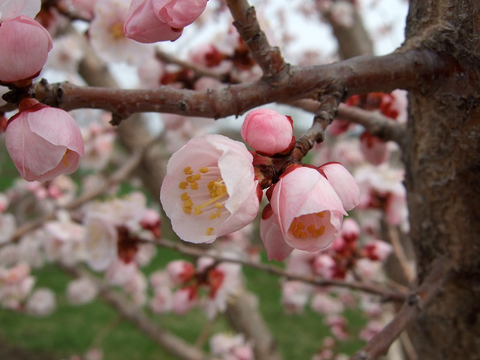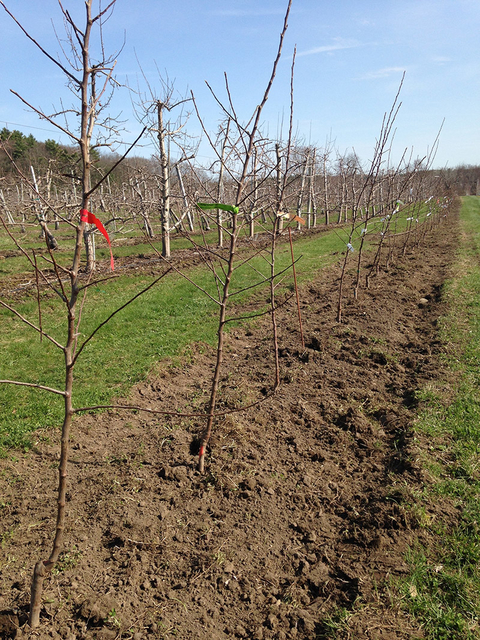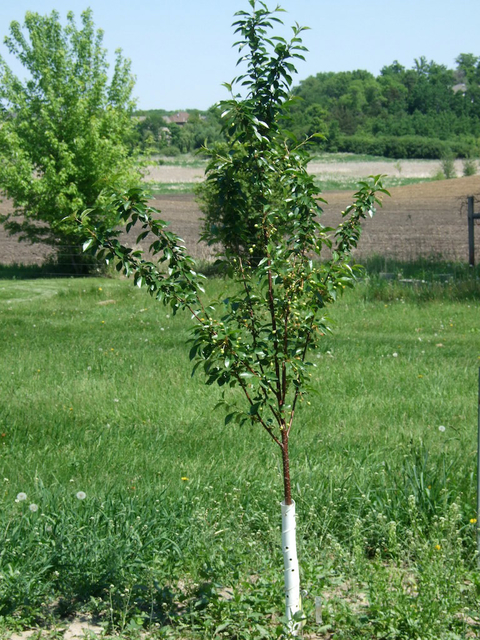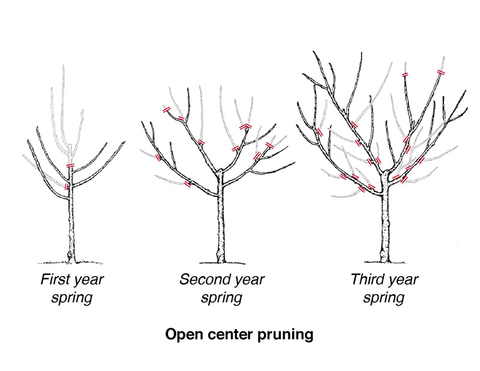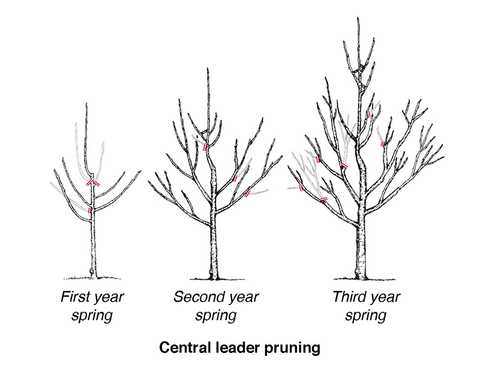Quick facts
- Stone fruit trees need full sun to produce the most fruit.
- Space trees 12 to 20 feet apart.
- Plant two different, compatible varieties to ensure fruit.
- Prune annually to maintain tree shape and a healthy, open canopy.
- Expect to get fruit 2 to 5 years after planting if you plant a 1 or 2-year-old tree.
- All stone fruits bloom very early in the spring. If flowers are damaged by freezing temperatures, you'll get no fruit that year, but you'll probably get fruit the following year.
Apricots, cherries, peaches and plums are called stone fruits because they have large pits or stones at their centers. Stone fruit trees are easy to grow, provided you accept a few limitations in northern climates.
In Minnesota, it is important to select varieties that are hardy to Zone 4 or Zone 3. Most stone fruit varieties are very much at home in Zone 5 and higher, but there are more varieties that are proving to be hardy in colder climates.
Growing stone fruits is tricky because they bloom early in the spring. Spring is notorious for temperature fluctuations in Minnesota. A few warm days might be followed by a cold night with frost—the biggest enemy of stone fruits. The delicate flowers are easily frozen, and a whole season's worth of fruit might be lost in a single cold night.
Stone fruits pose a bit of a challenge in Minnesota, but don't worry. The trees are relatively easy to grow and manage. They may not produce fruit every year, and they may not live as long as a cold-hardy apple tree, but if you enjoy eating these fruits the weather gamble is worth it. In the years you do get fruit, you will get a lot of it.
Caring for stone fruit trees through the seasons
March: For existing trees, prune before growth begins, after the coldest weather has passed.
April, May: If last year's growth was less than 12 inches, apply compost around the base of trees. Plant bare root trees as soon as the soil can be worked.
May, June: Plant potted trees after the threat of frost has passed.
May through October: Water trees as you would any other tree in your yard, particularly during dry spells.
June, July: Cut to the ground any root suckers near the tree; they look like stout seedlings and have similar leaves to the tree.
June through August: Place netting over trees as fruit ripens to prevent bird damage. Harvest ripe fruit.
October, November: Rake and compost fallen leaves and fruit. Apply tree wrap in late fall to prevent winter injury.
November through March: Watch for deer and vole damage; put fencing around trees if needed.
Choosing and buying plants
Variety tables provide hardiness, size and compatibility information for stone fruit varieties that have proven to do well in northern climates.
Remember, for most stone fruits, you will need to plant at least two trees that are compatible with each other to get fruit.
Hybrid plums and apricots are self-incompatible, which means they require at least two different varieties located within about 100 yards of one another for pollination to occur and fruit to be produced.
Hybrid plums require a specific second variety for pollination (see variety charts). For example, in order to get fruit from an Alderman plum, you would have to plant either a Toka or Superior plum as well (or a native American or Canadian plum).
European plums and tart cherries are self-compatible. They do not require two varieties to produce fruit, however they will generally produce more fruit if a second variety is nearby.
Select the right trees for your location and use these step-by-step instructions to plant and care for your young trees.
Stone fruit trees can be purchased as dormant, bare-root plants, or in pots.
- Bare root plants should be planted in early spring while they are still dormant (before visible growth starts), after the ground is workable but before the weather warms.
- Potted plants can be planted any time during the growing season, though spring is ideal, and trees may have leaves when planted.
Many local nurseries carry plum, cherry, apricot and even a few peach varieties suitable to this region.
- You can order fruit trees online, nurseries around the country carry many of the winter hardy varieties.
- Order early to get the best selection.
- If you order during the winter, the nurseries will wait to ship the trees until the appropriate time in spring.
Stone fruit species and hybrids for Minnesota
| Common name | Scientific name | Pollination | Mature height (estimate) |
|---|---|---|---|
| European plum | Prunus domestica | self-compatible | 15-20 feet |
| Hybrid plum | P. salicina x P. americana | self-incompatible; pollenizer required | 15-20 feet |
| Tart cherry | P. cerasus | self-compatible | 8-15 feet |
| Hybrid apricot | P. armeniaca x P. mandshurica | self-incompatible; pollenizer required | 15-20 feet |
Mature height listed in this and other tables is an estimate. Plant size at maturity will depend upon variety and growing conditions.
Plums are very much at home in the Minnesota garden, provided you choose the right varieties. There are quite a few hybrid plum varieties and a couple of European plum varieties that perform well in most areas of Minnesota. Local garden centers and online nurseries are carrying more and more hardy plums, making it easier for Minnesota gardeners to grow these delicious fruits.
Plums, along with tart cherries, are the most reliable stone fruits for Minnesota gardens. Fruit of various varieties ranges from deep purple to red to pale yellow, and the flavors are equally varied.
Most require a second compatible variety to ensure maximum pollination and good fruit set. Toka is the most highly recommended variety for cross-pollination, as it is compatible with many other varieties. The fruit of Toka is delicious too!
The following table includes suggestions for pollen-compatible varieties. Wild American plums (P. americana) and Canadian plums (P. nigra) can be good pollen sources for hybrid plum varieties. Truly wild plum trees are difficult to find at nurseries, but if you already have these trees in your yard they will provide pollen for your selected variety.
Varieties in bold were developed at the University of Minnesota.
Hybrid plums recommended for northern gardens
| Variety | Hardiness Zone 4 | Hardiness Zone 3 | Tree size | Pollen compatibility | Avg. harvest date | Description |
|---|---|---|---|---|---|---|
| Alderman (1986) | Good | Fair | to 20 feet | Superior, Toka, P. americana, P. nigra | Mid August | UMN's most famous plum. Attractive trees produce large, sweet, juicy fruit with burgundy skin and golden flesh. |
| BlackIce | Very good | Good | to 10 feet | Toka, P. americana, P. nigra | Late July to early August | U Wisconsin release (2006). Naturally dwarf tree with weeping form. Large 2-inch fruit has blue-black skin with deep red flesh. |
| LaCrescent (1923) | Very good | Good | to 15 feet | Toka, P. americana, P. nigra; NOT Superior | Late July to early August | Small to medium fruit with yellow skin and flesh. Juicy and very sweet with slight apricot flavor. Sharper flavor when canned. Vigorous grower but often a shy bearer. |
| Pembina | Very good | Good | to 15 feet | Toka, P. americana, P. nigra | Mid to late August | Introduced in South Dakota in 1923, extremely cold-hardy, possibly to zone 2. Large, pointed fruit has bright red skin and sweet, juicy yellow flesh. |
| Pipestone (1942) | Very good | Good | to 15 feet | Toka, P. americana, P. nigra | Mid August | Hardiness and adaptability to dry areas make it a valuable variety. Very large fruit has thin, tough, bright red skin enclosing medium-firm, melting, sweet golden flesh. |
| Superior (1933) | Good | Poor | to 15 feet | Alderman, Toka, P. americana, P. nigra; NOT LaCrescent | Mid August | Large fruit with bright red skin and yellow flesh. Rich, super-sweet flavor. |
| Toka | Good | Fair | to 20 feet | All other hybrid plum varieties, P. americana, P. nigra | Mid to late August | Recommended as a pollenizer tree. Fruit has deep magenta skin with golden flesh. Rich, spicy-sweet flavor. |
| Underwood (1920) | Very good | Good | to 15 feet | Toka, P. americana, P. nigra | Mid to late July | One of the oldest commonly available UM releases. Very hardy hybrid plum. Medium sized, heart-shaped fruit has red skin and soft yellow flesh. |
| Waneta | Very good | Good | to 15 feet | Toka, P. americana, P. nigra | Late July to early August | Developed in South Dakota in 1913, fruit has red skin with sweet, juicy yellow flesh. Very hardy. |
European prune-type plums recommended for northern gardens
| Variety | Hardiness zone 4 | Hardiness zone 3 | Tree size | Pollen compatibility | Avg. harvest date | Description |
|---|---|---|---|---|---|---|
| Mount Royal | Very good | Good | to 15 feet | Self-compatible | Mid to late August | Blue skin and yellow flesh. Heavy producer. Delicious right off the tree, but also well suited to drying and preserving. |
| Stanley | Fair | Poor | to 12 feet | Self-compatible | Early September | Blue skin and pale yellow flesh. The sweet, dry flesh of this plum makes it ideal for preserves and drying. Best grown in southern MN. |
Of all types of cherries, tart cherries (also known as pie or sour cherries) are best adapted to northern climates.
Tart cherry trees are small compared to their sweet-fruited relatives, growing only to about 15 feet tall, and a few varieties only to about 8 feet—perfect for small spaces.
These attractive, vase-shaped to rounded trees have stunning copper bark and beautiful dark green, glossy foliage. When in flower, the trees are covered with small, white, fragrant blossoms.
Later in summer, the bright red cherries are a vibrant contrast with the dark foliage. As autumn arrives, the foliage turns a lovely orange hue.
Of all stone fruits, tart cherries are the most self-fruitful, but a second compatible variety will ensure even better pollination and fruit set.
Varieties in bold were developed at the University of Minnesota.
Tart cherries recommended for northern gardens
| Variety | Hardiness: zone 4 to zone 3 | Tree size | Pollen compatibility | Avg. harvest date | Description |
|---|---|---|---|---|---|
| Evans/Bali | Very good to good | to 15 feet | Self-compatible | Mid July | Extremely cold-hardy. Large, bright red fruit with small pits. Fruit will sweeten if left on the tree and protected from birds. Sold as Evans or Bali, or Evans Bali. |
| Mesabi | Very good to fair | to 12 feet | Self-compatible | Late June-early July | A cross between a sweet and tart cherry, a bit sweeter than other tart cherry varieties. Bright red skin with pale red flesh. |
| Meteor (1952) | Very good to fair | to 14 feet | Self-compatible | Early July | This vigorous tree produces heavy crops of bright red fruit with yellow flesh. |
| North Star (1950) | Very good to fair | to 10 feet | Self-compatible | Late June-early July | Small stature makes North Star perfect for small spaces. Fruit has dark red skin and red flesh. Heavy producer. |
| Suda | Very good to fair | to 10 feet | Self-compatible | Late July | Deep red fruit has the darkest juice of the tart cherries. Great for processing and freezing. A little harder to find than other varieties. |
Apricots
Apricots are soft and tender, both in terms of fruit and personality.
There are only a couple of varieties that are hardy in Minnesota, and these are more delicate than plums or tart cherries. The fruit of hardy apricots isn't quite as juicy as those of warmer climates, but still has a delicious flavor and is excellent for making preserves.
Peaches
Peaches love warmth more than the other stone fruits, and so are the most limited for varieties that can be grown in Minnesota.
If you live in the southern part of the state or have a particularly mild micro-climate in your yard, you might have success with one of the few hardier peach varieties. These include Reliance, Contender, and Intrepid; befitting names for peaches growing in the North. Gardeners in the Twin Cities growing these varieties report they get a moderate crop of peaches every year or so. If you're a peach lover, it's certainly worth a try.
Varieties in bold were developed at the University of Minnesota.
Apricot varieties recommended for northern gardens
| Variety | Hardiness: zone 4 to zone 3 | Tree size | Pollen compatibility | Avg. harvest date | Description |
|---|---|---|---|---|---|
| Har-series | Fair to poor | to 20 feet | Self-compatible, but a second variety will increase fruit set | Late July-mid August | Includes Harcot, Harglow, Hargrand, Harogem, Harlayne. Developed in Canada. Can be difficult to find in U.S. nurseries. Sweet, good flavor. Good for fresh eating, preserves, drying. |
| Moongold (1960) | Good to fair | to 15 feet | Sungold | Late July | Medium size, sweet, juicy, freestone fruit. Earlier than Sungold. |
| Scout | Very good to good | to 20 feet | Harcot, Moongold, Sungold, Westcot | Early August | Best for canning, preserves, and drying. |
| Sungold (1960) | Good to fair | to 15 feet | Moongold | Early August | Small fruit has yellow skin with red blush. Yellow flesh is sweet and mild. |
| Westcot | Very good to good | to 20 feet | Harcot, Moongold, Scout, Sungold | Early August | A favorite among serious cold-climate apricot growers. Good for fresh eating. Harder to find than other varieties. |
Planting and caring for young trees
Learn how to choose a location, prepare for planting and space trees.
When planting multiple stone fruit trees, assume that the spread will be at least as great as the height. In other words, two trees with a mature height of 15-20 feet will need to be spaced at least 20 feet apart at planting.
- Bare root plants should be planted as soon as possible upon arrival.
- Do not allow the roots of bare root or potted plants to dry out at any time.
- Soak the roots of bare root plants in water for 2 to 4 hours before planting.
- Although potted plants may be held for several weeks before planting, they will require frequent water and fertilizer.
Find a sunny location
Choose the sunniest site available for planting, in a spot protected from harsh winds. Stone fruit trees require at least a half day of sun to produce fruit. The more sun they get, the more fruit they can produce.
Avoid planting stone fruit plants too close to the south side of buildings. Heat can get trapped there on sunny spring days and that will encourage trees to bloom too early.
Do not plant stone fruit trees where water stands after rain.
Dig a hole
At planting time, dig a hole large enough to fit the roots without bending them. Bent roots are less likely to spread normally as they grow, causing anchorage problems and susceptibility to drought.
If one root is very long it may be trimmed, but in general do not prune the roots.
Remove plants from pots
If the plant is root-bound or if larger roots circle the inside of the pot, make several vertical cuts through the roots with a sharp knife and spread them out. This will not harm the plant, rather it will encourage the roots to extend and grow out into the soil.
Do not fertilize the soil
Do not add fertilizer nor heavily amend the soil from the hole at planting time as this can create a 'flower pot' effect, where the roots never leave the amended soil. When this happens, plants become root-bound with poor anchorage and low drought resistance.
You may mix in compost or dampened, shredded peat moss to the soil, but make sure at least half the resulting mixture is original soil.
- Place the tree in the ground at the height at which it was grown in the nursery.
- You should be able to see the soil line on the tree.
- If you can't see it, place the tree so that the graft union is 3 to 4 inches above the soil line.
- Fill the hole with soil and firm the soil with your foot while holding the tree in position.
- Water immediately. If the soil compacts after watering, add more soil until it is at the right level.
Note: The methods used in the video apply to all stone fruit trees. Nematode testing is not required before planting stone fruit trees in Minnesota. Courtesy of Mike Parker, NCSU Extension
Protecting and mulching young trees
Spread about 4 inches of organic mulch, such as wood chips or well-rotted compost, around the base of the plant. Keep the mulch a few inches from the trunk to prevent rotting and rodent damage. Spread the mulch in a circle at least 4 feet in diameter.
Grass and weeds should be kept at least 2 feet from the trunk throughout the life of the tree. For this reason, you should renew the mulch annually.
Planting is also the perfect time to place a tree guard around the trunk. These can be found at most nurseries and garden centers. The tree guard should cover most of the length of the trunk, which will protect it from rodent damage and winter injury.
Watering
Regular watering is critical throughout the first year of planting.
- Young fruit trees require 1-2 inches of water a week, either rainwater or irrigation.
- If rain is plentiful, you might not need to irrigate very often.
- During hot, dry weather trees should be given about 5 gallons of water once a week.
Different soils and weather conditions will affect how much you'll need to water your tree.
Test to see if your tree needs water
- Check the soil at a depth of 4-8 inches (be careful not to dig into the soil too close to the roots of the tree).
- If the soil feels dry or slightly damp, give the tree a good watering.
Occasional, slow, deep watering will encourage the roots to grow deeply into the soil. Avoid frequent, shallow watering because this will encourage roots to stay near the soil surface, leading to poor anchorage, susceptibility to drought, and other stresses.
Do not wait for the leaves to wilt before watering.
It is just as important not to overwater new trees. Overwatering can lead to root rot and can kill the tree.
Remember, if you are watering your lawn near the tree, take this into account when determining the tree's water needs.
After the first year, regular rainfall should be sufficient for the tree. But watering will be required during hot, dry periods.
Support
Young trees benefit from staking at planting time to help them grow straight and develop a strong root system.
- Either a wood or metal stake will work.
- It should be about the height of the tree or taller after it is pounded two feet into the ground.
- Use a wide piece of non-abrasive material to secure the tree to the stake.
- Avoid narrow fastenings such as wire or string, as these will cut into the bark.
- The stake can be removed after 3 or 4 years, once the tree is well-established.
How to keep your stone fruit trees healthy and productive
Once established, a stone fruit tree planted on a favorable site in properly prepared soil should thrive with minimal fertilization.
Nitrogen is normally the only mineral nutrient that needs to be added on an annual basis and can be added using compost.
- After the first year, use the previous season's growth as a guide, and add compost in early spring if necessary.
- If the shoots of a young, non-bearing stone fruit tree grew 15 inches or more in length, you do not need to fertilize.
- For mature, bearing trees, the minimum shoot growth is 8 inches.
- If the previous year's growth falls below these amounts, then add compost.
Never fertilize a tree exhibiting normal or vigorous growth. Too much fertilizer is more harmful than too little.
If you fertilize the lawn surrounding a stone fruit tree, take this into account when calculating the amount to be applied to the tree.
Weeding
- For the first three to five years, grass and weeds should be removed from about a three-foot radius around the tree.
- Grasses can deplete soil moisture rapidly and will reduce tree growth.
- Apply a few inches of mulch around the base of a tree to help prevent weeds.
- Keep the mulch a few inches away from the trunk to prevent rodent damage and fungal growth.
Is it ripe?
As stone fruits ripen, the flesh softens and the skin changes from green to purple, red, orange, or a combination of these colors. You may test for ripeness by giving the fruit a light squeeze. The flesh should yield to gentle thumb pressure.
The best way to determine ripeness is to taste the fruit.
Picking fruit
To harvest without harming the fruit buds for next year's crop, twist the fruit slightly while pulling. Ripe fruit usually will detach from the stem with little effort. Handle fruit gently and avoid piling fruit too deeply to prevent bruising.
Storing fruit
Refrigerate stone fruits right after harvesting in perforated plastic bags or loosely covered containers. Keep the refrigerator at a temperature of 32-40°F.
Cherries will keep 3-5 days, while plums will keep 3-5 weeks when promptly refrigerated.
Stone fruit trees are susceptible to trunk cracking in winter, especially when the trees are young. Often this is caused by fluctuating temperatures as the winter sun warms the bark on very cold days.
To prevent cracking:
- Wrap the trunk with a paper or plastic trunk protector in late fall.
- The wrap should extend from the ground to just beyond the first scaffold branch base.
- The wrap can be removed when temperatures warm in spring.
Managing insects, wildlife and diseases
Significant insect pest damage is rare on stone fruits in home gardens, but these trees are occasionally subject to pests. Keep an eye on your trees so you notice any problems early on. If you see anything unusual (holes or scarring on fruit, deteriorating or dropped fruit, distorted or damaged leaves), there might be insect damage occurring.
- Plum curculio is a weevil that lays its eggs in flowers shortly after petals fall, and the resulting larvae tunnel into the fruit.
- Spotted wing drosophila is an invasive fruit fly that can be a major pest of stone fruit like cherries and plums. SWD damage can lead to brown rot disease on stone fruit.
- Eastern and black cherry fruit fly
- These fruit flies are only an issue in cherries.
- Adult flies for both species are about the size of a house fly and have black banding on their wings.
- Larvae are maggots, which are a quarter inch in size at their largest, that feed on fruit, causing it to be brown, mushy and inedible.
- To reduce future populations, remove dropped fruit to prevent flies from completing their life cycle and returning next year.
- The timing of insecticide treatments are challenging. Using a residual product, apply the first spray in the spring as cherry fruit flies are laying eggs and again 10 days later.
Birds are the main pests of stone fruits in Minnesota. They feed on maturing stone fruits, pecking holes or eating entire fruits. This is especially true for cherries.
The best protection is to net the entire plant, taking care to secure the netting both above and below the protected area.
Rodents can be a threat to stone fruit trees in winter, chewing the bark and the living tissue beneath it. Using tree guards on the trunk, enclosing the trunk in a wire-mesh cylinder and keeping mulch a few inches from the trunk will protect the tree from rodent damage.
Disease pressure is relatively low on stone fruits in Minnesota, however occasional problems do arise.
- Brown rot is the most serious disease of apricots, plums and tart cherries in Minnesota. It damages shoots and twigs and causes fruit to have brown bumps and shrivel.
- Black knot causes black, rough growths to form on the branches of some apricot, cherry and plum varieties.
- Only affecting plums, plum pocket causes unripe plums to grow up to ten times their normal size.
- In southern Minnesota, cherry leaf spot can defoliate entire trees.
- Trunk canker diseases can form in the trunks of tender stone fruit trees after winter injury or other injuries caused by wounds in the trunk. These diseases enter the trunks through the wounds and gradually kill the trees over several years, by cutting off water and nutrient movement through the tree. Prevent this by planting cold hardy varieties, which are more resistant to winter damage.
Pruning
The goals of pruning and training are to maximize light penetration into the tree and to maintain healthy fruiting wood.
- Remove diseased, broken, or dead branches.
- Remove any downward-growing branches.
- If two limbs are crossed, entangled, or otherwise competing, remove one of them completely at its base.
- Remove any limb along the trunk that is getting bigger in diameter than the trunk.
- Remove suckers coming up from the roots or low on the trunk.
- Remove watersprouts, which are vigorous vertical branches.
- Pruning cuts should be made close to the branch collar at the base of the limb. For larger limbs, first cut on the underside of the limb to avoid tearing the bark.
- Remove large limbs first and start in the top of the tree.
- Thinning cuts remove entire branches at the branch collar and are almost always recommended. Heading cuts remove only part of a branch and encourage unwanted vegetative growth just below the cut.
The goals of pruning and training are to maximize light penetration into the tree and to maintain healthy fruiting wood.
For new trees
At planting, if the tree has branches, choose four to six of them, starting about 18 to 24 inches above the ground and spaced as equally as possible around the tree, to form the first tier of scaffold branches. These branches should not all be at the same height on the trunk. Prune out all remaining branches.
If the newly planted tree does not have at least three strong branches suitable for the primary tier, remove all branches and prune the leader at a height of 30-40 inches from the ground.
Once branches begin to sprout from the trunk, you can select scaffold branches and remove any unwanted branches while they are still small. This pruning may be done through mid-summer if necessary.
Prune once a year
Fruit trees should be pruned on an annual basis in late winter, preferably after the coldest weather is past and before buds break and growth begins. Use the open-center pruning method described in the next drawer.
Prune minimally, especially with young trees, as excessive pruning will delay or reduce fruiting and encourage too much leafy growth.
Once the first set of scaffold branches has been selected, choose a second set above it, with the new scaffold branches beginning about 12 inches above the top branch of the first.
In the second year and thereafter, prune in early spring, usually March or April in Minnesota.
If you were able to select first-tier branches in the previous year, you may select four to six second-tier branches.
- These should begin about 18-20 inches above the first tier
- Spaced as equally as possible around the trunk
- At different heights from one another
Remove all other branches not belonging to the first or second tiers and prune out the leader.
Stone fruit trees are often pruned to an open center form, following their naturally spreading growth habit.
This produces a vase-shaped tree, which
- Provides good air circulation through the canopy of the tree
- Helps prevent brown rot and other fungal diseases that may occur in a canopy that is too dense
- Keeps the many fruits on a stone fruit tree within reach
The illustration below shows the contrasts between open center (left) and central leader (right) method of pruning.
You can see in the open center method, the center vertical stem is immediately pruned out upon planting. This encourages scaffold branches to grow, which will become the foundation of the open center tree.
Central leader pruning is used for trees that have more of an upright growth habit (like many apples). Occasionally you'll find a stone fruit tree that has a naturally upright habit, in which case the central leader method might be the best choice.
This video explains pruning peach trees to an "open center" style. This method can be used for all other stone fruit trees. Video courtesy of Mike Parker, NCSU Extension.
Renovating an old tree
Pruning a mature tree that has been neglected for several years can be a challenge and will take a few years of pruning to make the tree productive again. Here are a few guidelines for renovating a neglected tree:
- Choose a branch to be the leader; or if the tree has more of a spreading habit, choose which limbs will remain to be the foundation of the tree. Remove one of two major limbs that might be competing with these main branches.
- Then decide on additional branches to save based on the branch position around the trunk. Think balance.
- At this stage, pruning out a few large branches in year one will open the tree up, and increase light and airflow.
- Don't prune too much or the tree will put all its energy into making new branches and not fruit.
- During year 2, make a few more decisions on where branches should remain and remove a few more.
- Follow general pruning guidelines to prune out branches that are diseased or broken.
Reviewed in 2024


